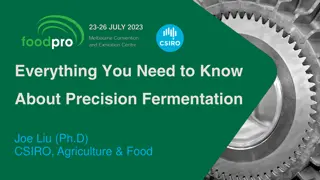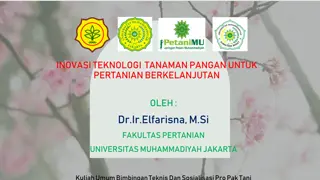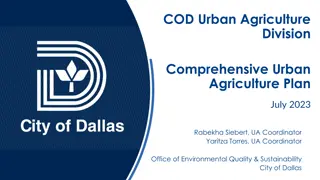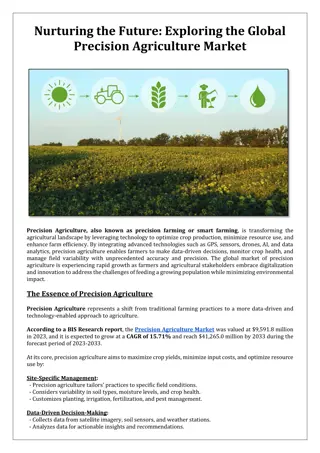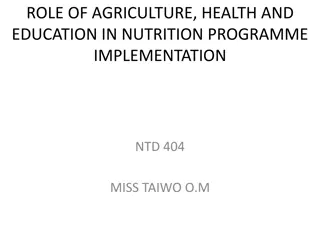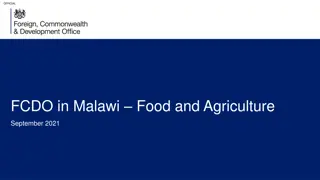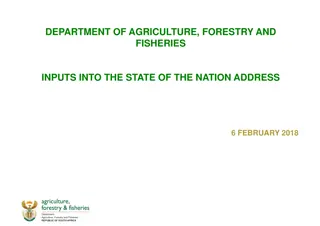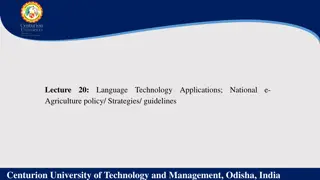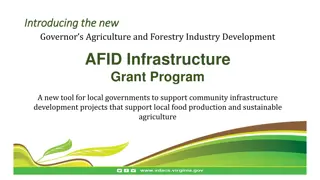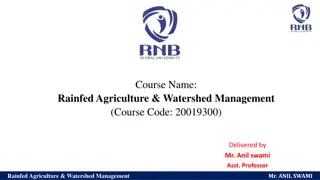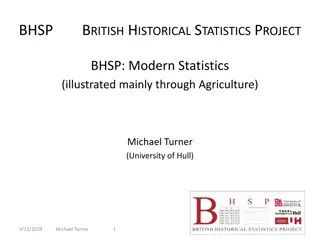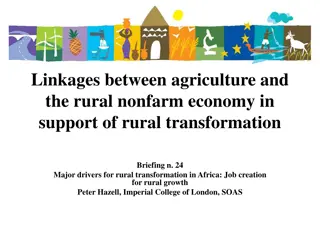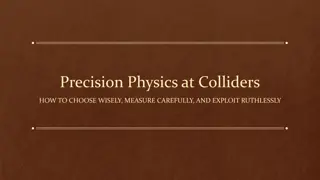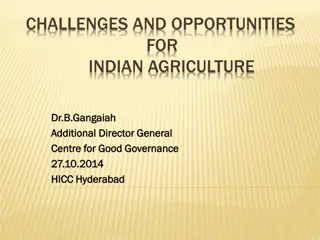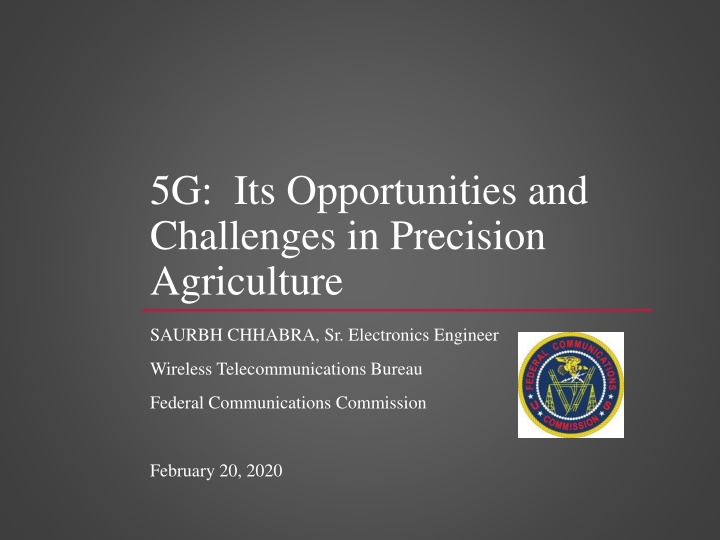
5G Opportunities and Challenges in Precision Agriculture
The presentation discusses the opportunities and challenges that 5G technology presents in the field of precision agriculture, aiming to improve efficiency and productivity through enhanced connectivity and data rates. It covers the capabilities, key enabling technologies, spectrum capabilities, and use cases of 5G in agricultural settings.
Uploaded on | 2 Views
Download Presentation

Please find below an Image/Link to download the presentation.
The content on the website is provided AS IS for your information and personal use only. It may not be sold, licensed, or shared on other websites without obtaining consent from the author. If you encounter any issues during the download, it is possible that the publisher has removed the file from their server.
You are allowed to download the files provided on this website for personal or commercial use, subject to the condition that they are used lawfully. All files are the property of their respective owners.
The content on the website is provided AS IS for your information and personal use only. It may not be sold, licensed, or shared on other websites without obtaining consent from the author.
E N D
Presentation Transcript
5G: Its Opportunities and Challenges in Precision Agriculture SAURBH CHHABRA, Sr. Electronics Engineer Wireless Telecommunications Bureau Federal Communications Commission February 20, 2020
Agenda What is 5G? 5G: Opportunities in Precision Ag 5G: Challenges in Precision Ag FCC Efforts to Realize the Opportunities of 5G 2
ITU defines IMT-2020 (5G) as: Parameters Target User experienced data rates 100 Mbps Peak data rates 20 Gbps Mobility up to 500 km/h with acceptable QoS Latency (air interface) 1 ms Connection density 106/km2 Network energy efficiency 100 times better than IMT-Advanced Spectrum efficiency 3 times better IMT-Advanced Area traffic capacity 10 Mbit/s/m2 Source: 4 ITU, Study Group 13, Telecommunication Standardization Sector, Report: TD 208 (PLEN/13)
Capabilities of 5G Source: https://www.qorvo.com/design-hub/blog/getting-to-5g-comparing-4g-and-5g-system-requirements 5
5G Use Cases 6 Source: https://www.testandverification.com/5g-usage-scenarios-nsa-sa
Spectrum Capabilities in General High Band CAPACITY Mid-Band Low-Band COVERAGE 7
Some Key 5G Enabling Technologies 8 Source: Nokia, Enabling Technologies for 5G, The next generation network, June 1, 2018, Dr. Brian Cho
5G Opportunities in Precision Ag 5G Mobile/Fixed can provide coverage in rural areas IoT coverage can exist even w/o 5G high-speed coverage Coverage IoT sensors can be readily deployed to improve efficiency (improving production/yields and reducing waste) IoT Lower latency & edge computing capabilities of 5G can allow Artificial Intelligence, Robotics, and Automation to further improve efficiencies Robotics 11
5G: Challenges in Precision Ag Broad 5G coverage is lacking in rural areas Shift spectrum resources from 4G to 5G (DSS) 5G Coverage 5G RAN, Core & Devices Benefits of 5G will be fully realized with development of 5G Radio Access Network, 5G Core, and 5G Device ecosystem Many IoT sensors only need low-speed internet access (though some may need higher speeds) Some automation/robotics applications may need high-speed internet access and edge computing Precision Ag Applications 13
FCC Efforts to Realize the Opportunities of 5G Making spectrum available for 5G: Recent 28/24/37/39/47 GHz auctions provide ~5 GHz of high-band spectrum for 5G Our work on the 2.5 GHz, 3.5 GHz, and 3.7-4.2 GHz bands could make more than 600 megahertz of mid-band spectrum available for 5G deployments Improvements to low-band spectrum (useful for wider coverage) with targeted changes to the 600 MHz, 800 MHz, and 900 MHz bands Creating new opportunities for the next generation of Wi-Fi in the 6 GHz and above 95 GHz bands Updating infrastructure policy and encouraging private sector to invest in 5G networks Modernizing outdated regulations to promote the wired backbone of 5G networks Source: https://www.fcc.gov/5G 15
FCC Efforts to Realize the Opportunities of 5G The Broadband Deployment Advisory Committee (BDAC) at FCC provides advice and recommendations for the FCC on how to accelerate broadband deployment Recently established Precision Ag Connectivity Task Force at FCC will provide recommendations to the FCC on how to advance broadband deployment to unserved agricultural lands for use of precision ag technologies Chairman Pai intends to establish the 5G Fund, which would make up to $9 billion available to deploy advanced 5G mobile wireless services in rural America; at least $1 billion specifically for deployments facilitating Precision Ag FCC established the Rural Digital Opportunity Fund, which, through a two-phase reverse auction mechanism, will provide up to $20.4 billion over ten years to finance up to gigabit-speed broadband networks in unserved rural areas Source: https://www.fcc.gov/5G, https://www.fcc.gov/task-force-reviewing-connectivity-and-technology-needs-precision-agriculture-united-states, https://www.fcc.gov/document/fcc-launches-20-billion-rural-digital-opportunity-fund 16
Concluding Remarks 5G presents many opportunities in Precision Ag Broadband Coverage to Rural Areas AI/Automation/Robotics with high-speed and low-latency connectivity IoT use even in areas with low-speed connectivity 5G presents challenges as well 5G lacks broad coverage and spectrum use will need to shift from 4G to 5G Deployment of 5G RAN, 5G Core, and Edge Computing may be needed for use of AI/Automation/Robotics in Precision Ag There may be other opportunities and challenges that will come with implementation of 5G and its use in Precision Ag; but, by working together, government and industry can help realize the potential of 5G and find solutions to overcome the challenges. 17


